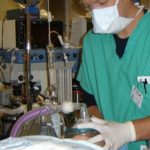
Certified registered nurse anesthetists are advanced practice nurses who safely provide more than 40 million anesthetics for surgical, obstetrical and trauma care each year in the United States. They administer every type of anesthetic, work in every type of practice setting and provide care for every type of operation or procedure – from open-heart surgery to pain management programs.
Nurse anesthetists provide anesthetics to patients in collaboration with surgeons, anesthesiologists, dentists, podiatrists and other qualified health care professionals. As advanced practice registered nurses, they are given a high degree of autonomy and professional respect.
A nurse anesthetist takes care of a patient’s anesthesia needs before, during and after surgery or the delivery of a baby by:
- Performing a physical assessment
- Participating in preoperative teaching
- Preparing for anesthetic management
- Administering anesthesia to keep the patient pain free
- Maintaining anesthesia intraoperatively
- Overseeing recovery from anesthesia
- Following the patient’s postoperative course from recovery room to patient care unit
Currently, around 50,000 nurse anesthetists practice in the United States – approximately 40% of whom are men (as compared with 10% in the nursing profession as a whole). Nurse anesthetists are the sole providers of anesthesia in approximately two thirds of all rural hospitals in the United States, enabling these health care facilities to offer obstetrical, surgical and trauma stabilization services.
Nurse anesthetists have been providing anesthesia in the United States for over 150 years, beginning with their care of wounded soldiers during the Civil War.
Working Conditions
Nurse anesthetists practice in every setting in which anesthesia is delivered: traditional hospital surgical suites and obstetrical delivery rooms; critical access hospitals; ambulatory surgical centers; the offices of dentists, podiatrists, ophthalmologists, plastic surgeons and pain management specialists; and military, Veterans Affairs’ and Public Health Service health care facilities.
Salary Range and Outlook
Nurse anesthetists carry a heavy load of responsibility and are compensated accordingly. The average annual salary in 2023 was over $200,000 a year, according to the Bureau of Labor Statistics (BLS).
The job outlook for advanced practice registered nurses is good. The BLS notes that jobs are expected to grow 40% between 2023 and 2033, much faster than the average.
Academic Requirements
To become a nurse anesthetist, you must first become a registered nurse (RN) with a Bachelor of Science degree and at least one year of experience in an acute care setting.
The next step is to apply to and be accepted by an accredited nurse anesthesia program.
These graduate programs range in length from two to three years. The classroom curriculum emphasizes anatomy, physiology, pathophysiology, biochemistry, chemistry, physics and pharmacology. All programs include clinical training in university-based or large community hospitals. The average student nurse anesthetist completes almost 2,500 clinical hours and administers about 850 anesthetics.
Once you graduate, you will take a national certification exam, which you must pass to begin practice. As a certified registered nurse anesthetist, you will be required to continue your education by obtaining a minimum of 40 hours of approved continuing education every two years, documenting your practice and maintaining your state licensure.
Learn More About a Career as a Nurse Anesthetist
- Watch a video about the role of nurse anesthetists.
- Read stories about the work nurse anesthetists do.
- Take a look at “Become a CRNA” for more information and additional resources.
